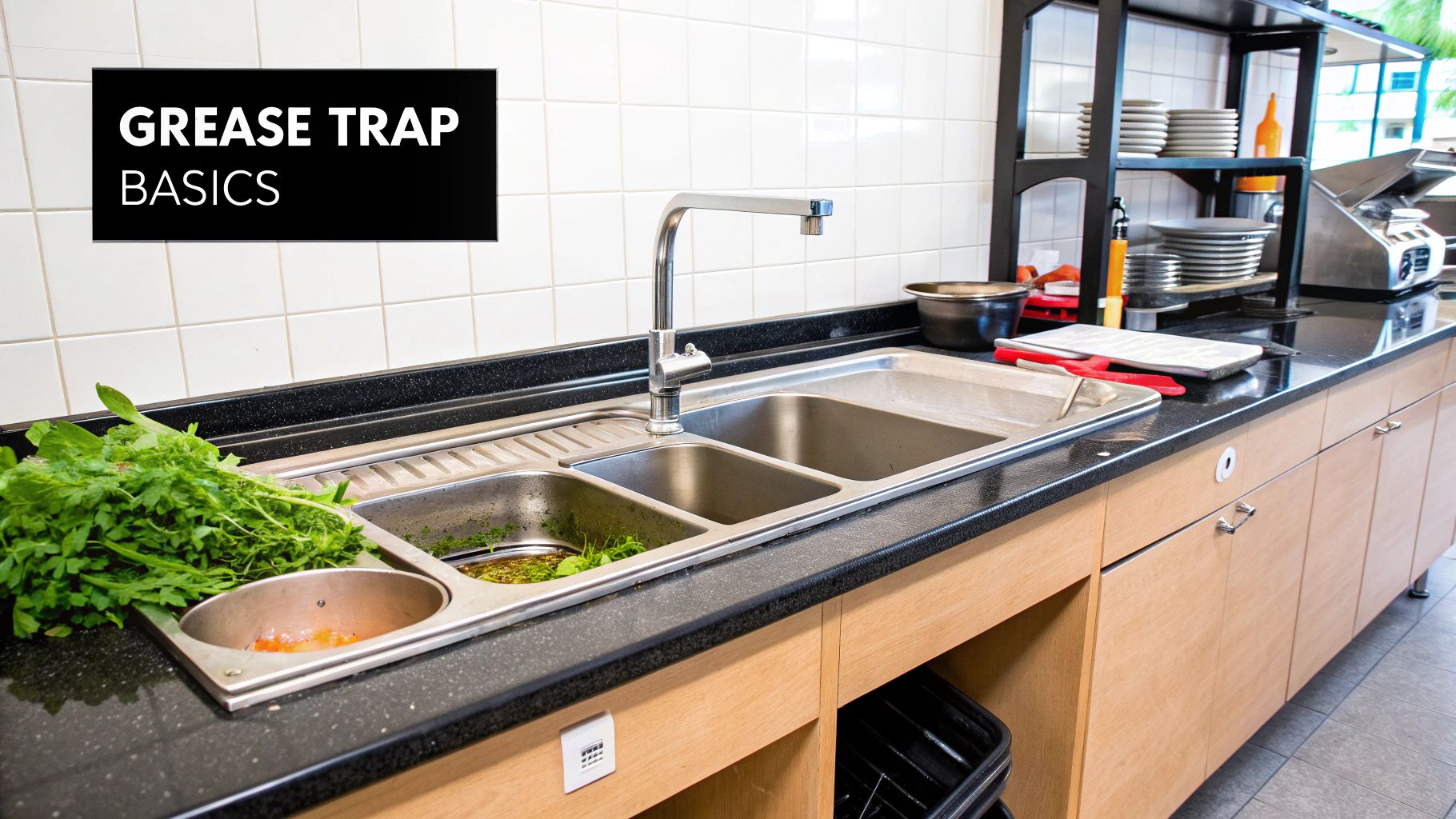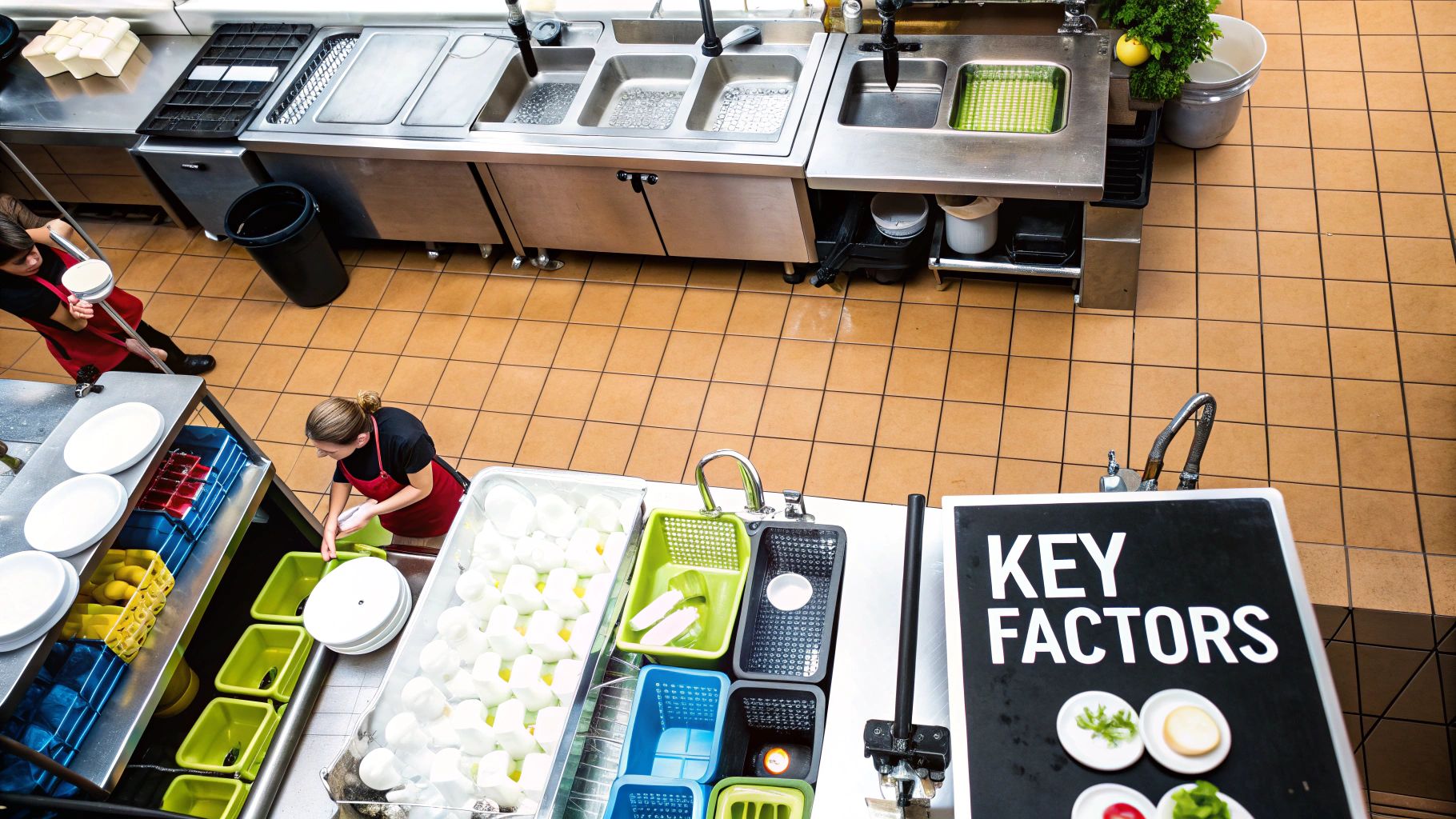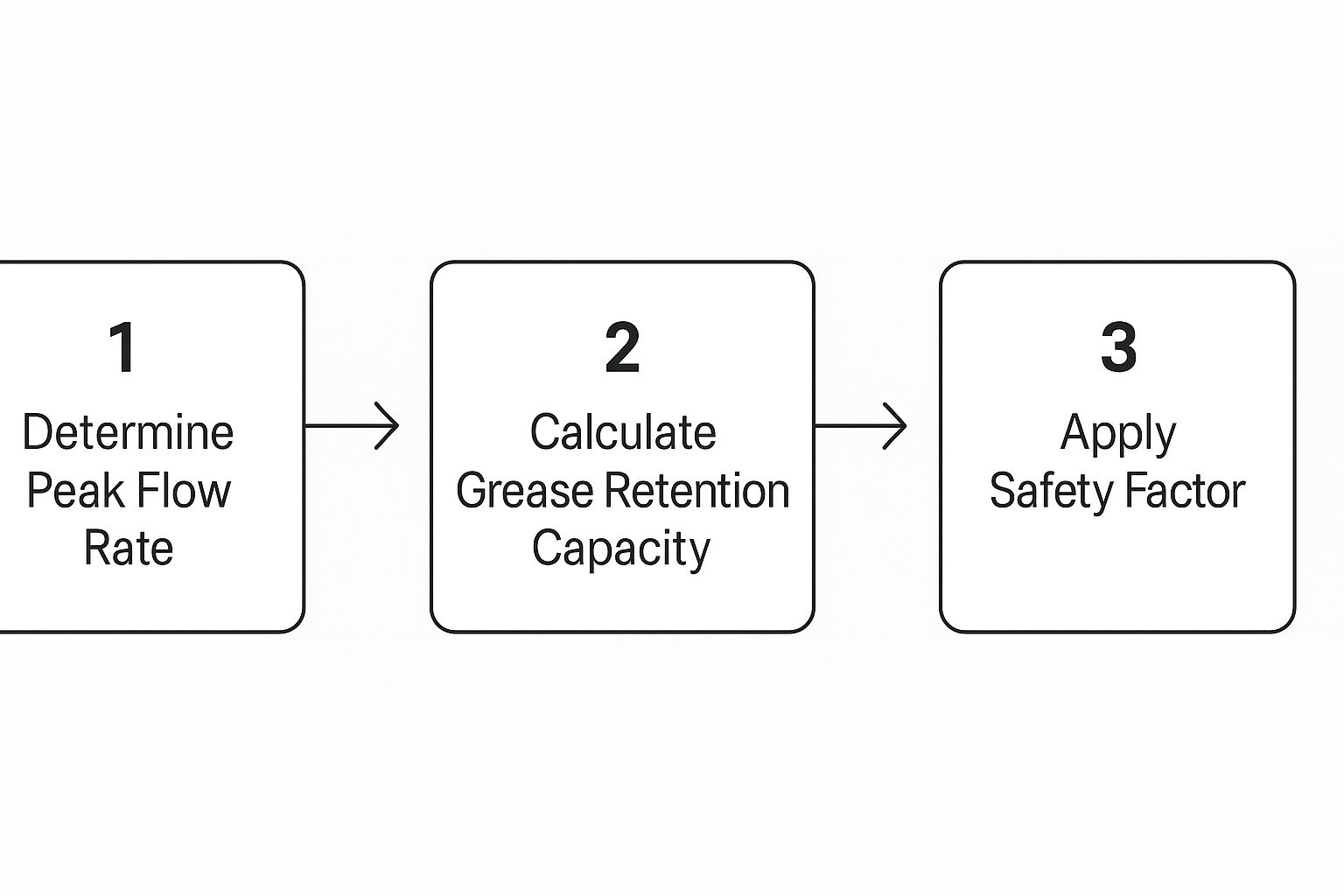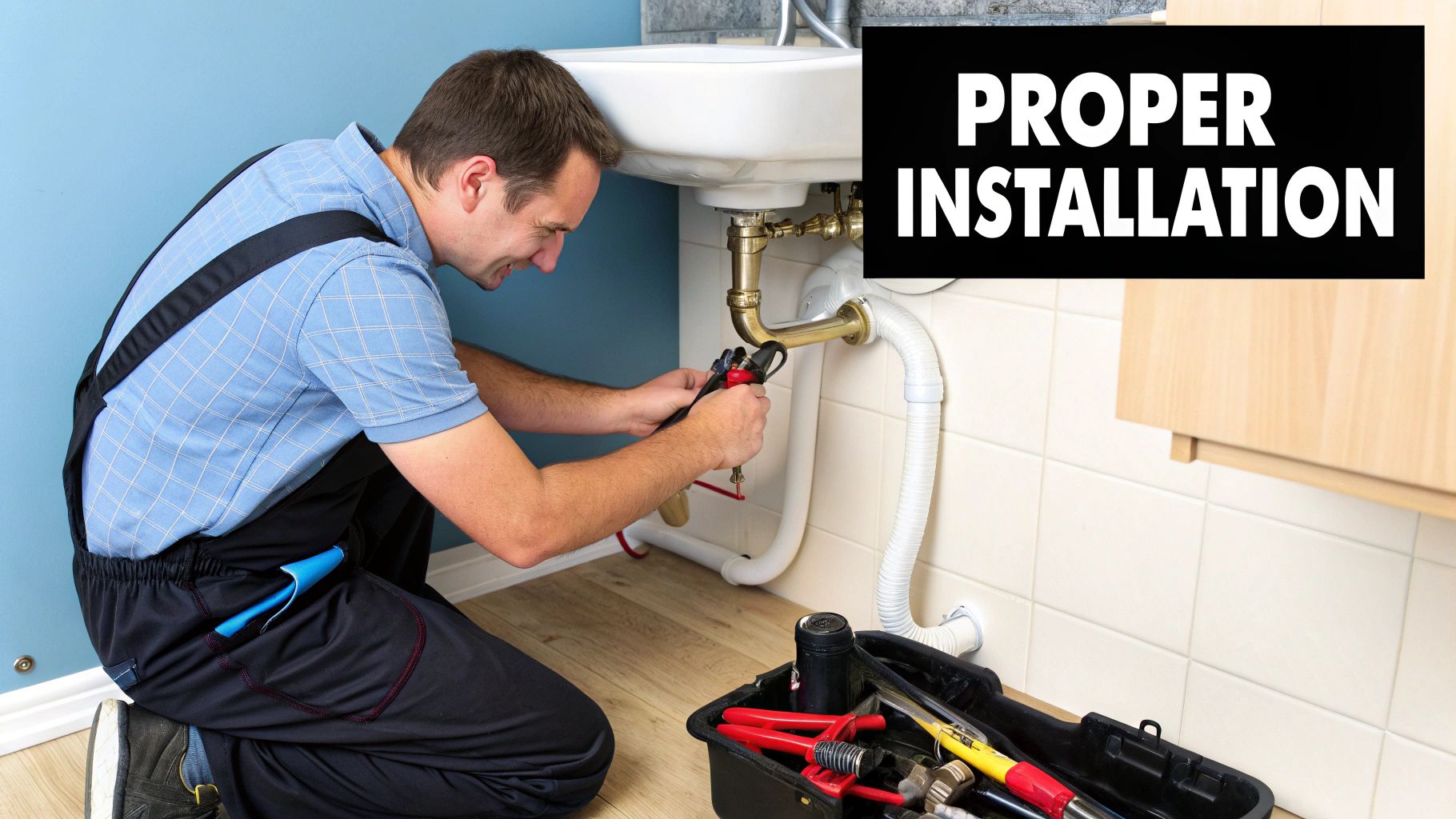
Pizza Restaurant Grease Trap Sizing Done Right
Share
Properly sizing a grease trap for a pizza place is a different beast altogether. Standard calculations you might use for other restaurants just don't cut it, mainly because they fail to account for the massive amount of fats, oils, and grease (FOG) that comes from cheese and meat toppings. Getting this right means looking at every single sink and dishwasher—especially the sinks on your pizza prep tables—if you want to avoid gnarly backups and hefty fines from the city.
It’s about understanding your pizzeria's unique FOG profile, not just plugging numbers into a generic formula.
Why Pizzerias Have Unique Grease Trap Needs

Let's be honest, sizing a grease trap for a pizzeria isn't like doing it for a coffee shop. The real challenge, and where I see a lot of owners get tripped up, comes from the hidden grease sources that are easy to overlook. Sure, the pizza ovens don't produce wastewater, but pretty much all the equipment used to prep and serve those pizzas does. This creates a specific FOG profile that can overwhelm an undersized system in no time.
You have to think beyond the main three-compartment sink. The true grease load in a pizzeria is a perfect storm coming from multiple sources:
- Cheese and Meat Toppings: This is the big one. High-fat ingredients like mozzarella, provolone, pepperoni, and sausage are the primary culprits. Every time a pan, utensil, or cutting board gets washed, all that rendered fat flows straight down the drain.
- Dough Preparation: A lot of pizza dough recipes call for olive oil. It might not seem like much, but when you're washing dough mixers, proofing bins, and prep surfaces all day, it adds up and contributes to the total grease output.
- High-Temperature Dishwashers: These machines are powerful. They're designed to blast away baked-on cheese and grease from pans, but where does all that melted FOG go? You guessed it—right into your plumbing.
- Pizza Prep Table Sinks: The sinks on your prep line are FOG hotspots. They’re constantly being used to rinse utensils and hands caked in oily residue from toppings like pepperoni and cheese. Even the best commercial food prep equipment needs a correctly sized trap to handle the waste it generates.
The Financial Risk of Getting It Wrong
Let me be blunt: under-sizing your grease trap is a fast track to frequent plumbing backups, foul odors that will absolutely drive customers away, and eye-watering municipal fines. When a trap is too small, it fills up way too fast. Once it's full, it can no longer separate FOG from water, and it starts letting raw grease escape into the sewer lines.
This is a massive headache for city infrastructure. In fact, grease is the primary cause of over 70% of clogging issues reported in municipal wastewater systems.
This widespread problem is exactly why the grease trap service industry is booming. Proper sizing from the get-go is your first and best defense against becoming another statistic and facing penalties.
Ultimately, trying to save a few bucks with a smaller trap almost always backfires. The money you thought you saved will be quickly eaten up by emergency plumbing calls and more frequent professional cleanings. A correctly sized grease trap isn't an expense; it's a smart long-term investment in keeping your pizzeria open and your kitchen running smoothly.
Decoding the Main Grease Trap Sizing Methods
 When you get into grease trap sizing, you’ll quickly find there are two main roads you can go down: calculating by Gallons Per Minute (GPM) or by Drainage Fixture Units (DFU). Plumbers and inspectors use both, and knowing how they work is critical because your local health department will almost certainly have a preference.
When you get into grease trap sizing, you’ll quickly find there are two main roads you can go down: calculating by Gallons Per Minute (GPM) or by Drainage Fixture Units (DFU). Plumbers and inspectors use both, and knowing how they work is critical because your local health department will almost certainly have a preference.
Let's cut through the technical jargon and see how this applies directly to a real-world pizza kitchen.
The GPM method is pretty much what it sounds like. It figures out the maximum potential flow of wastewater coming from all your fixtures at once. I've found this approach is really practical for pizzerias because it directly ties the grease trap size to your specific equipment—from that big three-compartment sink where you scrub pans to the high-temp dishwasher blasting off baked-on cheese.
Even that small hand sink built into your commercial pizza prep table has to be part of the equation. It might not seem like much, but the constant rinsing of utensils caked with cheese and oily toppings definitely adds to the total flow your trap has to handle.
Calculating with Gallons Per Minute
To figure out the GPM, you start by measuring the volume of each sink basin (Length x Width x Depth in inches) and then convert that measurement into gallons. After that, you have to factor in how quickly it drains. It's a pretty straightforward way to get a real-world estimate of the load your grease trap will be up against during a slammed dinner rush.
A huge piece of this puzzle is the retention time—that’s the minimum time water needs to sit inside the trap to give the FOG (fats, oils, and grease) a chance to separate and rise to the top. For pizzerias with high grease loads, a retention time of at least 30 minutes is often required. For example, a commercial kitchen with a peak flow rate of 50 GPM would need a grease trap sized for at least 1,500 gallons (50 GPM × 30 minutes).
This isn't just a suggestion; it’s a critical design factor. Globally, an estimated 60-70% of grease trap failures are traced back to improper sizing.
Understanding Drainage Fixture Units
The other path is the Drainage Fixture Units (DFU) method. Instead of calculating the actual water your sinks can hold, plumbing codes assign a standardized value—a DFU number—to every type of fixture. A big three-compartment sink might be rated at 3 DFUs, while a small hand sink on a pizza prep table is 1 DFU.
To find your total, you simply add up the DFU values for every single drain that will connect to the grease trap. That final number corresponds to a required grease trap size on a chart provided by your local plumbing authority.
This method is less about the specifics of your operation and more about a standardized, code-based assessment. For a pizza restaurant, this means every single drain adds to the count:
- Three-compartment sink for washing pans
- Two-compartment sink on the pizza prep table
- High-temperature dishwasher
- Floor drains near the prep line
- Mop sink
While the GPM method often feels more precise for a pizzeria's actual output, I’ve seen many inspectors prefer the DFU method. Why? Because it’s standardized and much easier for them to verify against the official plumbing codebook. The best advice I can give is to always check which method your municipality requires before you buy anything.
A Real-World Sizing for a Pizza Restaurant
Talking about grease trap sizing in theory is one thing, but seeing how it all comes together in a real-world kitchen is where it really clicks. Let's walk through the numbers for a typical pizzeria, a place notorious for high FOG (Fats, Oils, and Grease) from all that glorious cheese, meat toppings, and oily dough.
Picture a busy pizza shop on a Friday night. The main culprits pumping greasy water down the drains are a three-compartment sink for washing oily pans, a two-compartment sink on the pizza prep table, a high-temp dishwasher, and a floor drain right in the splash zone of the prep line. Applying the right formulas here takes all the guesswork out of choosing a trap.
Calculating Peak Flow Rate with GPM
The Gallons Per Minute (GPM) method is perfect for a pizzeria because it’s all about the maximum volume of water your sinks can dump at once. We’ll start with the workhorse of any pizza kitchen: the three-compartment sink.
Let's say each basin is 24 inches long x 24 inches wide x 14 inches deep. To get the volume, we calculate: (24" x 24" x 14") / 231 cubic inches per gallon = 34.8 gallons
Of course, nobody fills sinks to the absolute brim. A more realistic level is 75% capacity, which gets us to 26.1 gallons. If that basin drains in one minute, you're looking at a flow rate of 26.1 GPM. Since there are three basins, we have to account for the possibility of them all draining at once: 3 x 26.1 GPM = 78.3 GPM.
Next up is the two-compartment sink at the pizza prep table. These are usually a bit smaller, say 18" x 18" x 12". (18" x 18" x 12") / 231 = 16.8 gallons. At 75% capacity, that’s 12.6 gallons per basin. With two basins, the total flow from this sink is 25.2 GPM.
To get our peak flow rate, we just add them up: 78.3 GPM (3-comp sink) + 25.2 GPM (prep sink) = 103.5 GPM. We generally don't add the dishwasher's flow directly because its discharge is controlled and usually much slower than a sink's full-bore drain rate.
Factoring in Retention Time and Grease Capacity
Once we have our peak flow rate, we need to apply the retention time. This is how long the water needs to sit in the trap for grease to separate and float to the top. Most health codes demand a 30-minute retention time for restaurants like pizzerias.
Grease Trap Size (Gallons) = Flow Rate (GPM) x Retention Time (Minutes) 103.5 GPM x 30 minutes = 3,105 Gallons
That’s a big number, but it reflects the massive potential FOG output of a busy pizzeria. There's another handy rule of thumb: the trap's grease storage capacity (in pounds) should be at least twice its GPM flow rate.
- Pounds Capacity = GPM x 2
- 103.5 GPM x 2 = 207 pounds of grease
A 3,000-gallon grease trap would easily meet this requirement. This shows just how critical proper sizing is for managing the heavy grease load from ingredients like pepperoni and mozzarella.
This process—from measuring fixtures to applying safety factors—is what ensures your system can handle the worst-case scenario.

As the visual shows, it’s not just one calculation but a series of steps to make sure you’re compliant and effective.
Sizing with Drainage Fixture Units
Now, let's try another common approach: the Drainage Fixture Unit (DFU) method. Some inspectors prefer this because it's based on standardized values from plumbing codes. We just assign a DFU value to each fixture and add them up.
For our sample pizzeria, the DFU values might look something like this:
Fixture Unit (DFU) Values for a Sample Pizzeria
| Fixture Type | Typical DFU Value | Notes |
|---|---|---|
| Three-Compartment Sink | 3 DFUs | The primary source of pan-washing wastewater. |
| Pizza Prep Table Sink (2-comp) | 3 DFUs | Handles frequent rinsing of greasy utensils. |
| High-Temp Dishwasher | 4 DFUs | Processes greasy pans, adding a significant load. |
| Floor Drain (near prep) | 2 DFUs | Catches spills and washdown from the highest FOG area. |
| Total DFUs | 12 DFUs |
A grand total of 12 DFUs usually corresponds to a 75 GPM grease trap according to a standard plumbing code chart. If we apply that same 30-minute retention time: 75 GPM x 30 minutes = 2,250 Gallons.
Notice that the DFU method gave us a smaller trap size than our GPM calculation. This is pretty common. For a high-FOG place like a pizzeria, I’ve found the GPM method often gives a more realistic and safer estimate of what you’ll actually need. Using this real-world example as a guide for your own shop will help you confidently figure out the right grease trap size and avoid costly mistakes down the road.
Navigating Local Codes and Inspector Rules
 After all the math with flow rates and fixture units, what's the single most important factor in sizing your grease trap? It’s whatever your local inspector says it is. I’ve seen perfectly calculated plans get rejected flat-out because they didn’t meet a specific local rule.
After all the math with flow rates and fixture units, what's the single most important factor in sizing your grease trap? It’s whatever your local inspector says it is. I’ve seen perfectly calculated plans get rejected flat-out because they didn’t meet a specific local rule.
At the end of the day, their word is law. Your first move should always be to get in touch with your city or county’s water authority or health department. Ask them for their Fats, Oils, and Grease (FOG) program guidelines. This document is your roadmap to getting that final sign-off.
Understanding Common Code Variations
Don’t make the mistake of assuming a standard code exists for grease traps—it doesn't. I've seen wild variations in requirements from one town to the next, especially for high-FOG businesses like pizzerias.
Here are a few common curveballs you might encounter:
- Mandatory Minimum Sizes: Some jurisdictions set a non-negotiable floor. They might demand a 1,500-gallon trap for any new pizzeria, period. It doesn't matter what your calculations show; this is their baseline for protecting the public sewer system.
- Specific Retention Times: While 20 or 30 minutes is a common industry guideline, your local code might insist on something different for a pizza shop. A longer retention time means you'll need a bigger tank, simple as that.
- Fixture Connection Rules: Inspectors get very particular about what drains into the trap. Your three-compartment sink is a given. But for a pizzeria, they will absolutely look for sinks at the pizza prep table and any floor drains to be properly routed as well.
This is where hiring a commercial plumber who specializes in restaurant work can save you a world of hurt. They speak the same language as inspectors and know the local rulebook inside and out.
Preparing for a Smooth Inspection
When it's time to submit your plans for a plumbing permit, you need to be ready with a complete package. The inspector wants to see the whole picture, not just the trap itself.
Be prepared with site plans, a detailed kitchen floor plan showing every single fixture (especially all sinks on pizza prep tables), and the manufacturer’s spec sheet for the grease trap you've chosen. Coming in with thorough, professional documentation shows you're serious and makes their job easier.
This level of regulatory oversight is a big reason why the global grease trap market, valued at USD 1.34 billion, keeps growing. As environmental rules get stricter, the pressure for compliant FOG management systems only increases.
Think of your local water authority as a long-term partner. Building a good relationship and showing you understand their FOG program from day one will help keep you off their radar for violations and fines down the road.
Costly Sizing Mistakes Pizza Shop Owners Make
I've seen it happen time and time again. A new pizza shop owner, trying to be smart with their budget, ends up paying double or triple down the road because of a simple sizing miscalculation. Learning from their missteps is a lot cheaper than making them yourself, especially when it comes to something as critical as a grease trap.
Getting this wrong leads to emergency plumbing bills on a busy Friday night, hefty fines from the health department, and the kind of operational chaos that can sink a new business. A smart, future-proof investment starts by sidestepping these common pitfalls.
One of the most frequent oversights is forgetting about the "hidden" sources of fats, oils, and grease (FOG). Everyone remembers to account for the big three-compartment sink, but what about the constant stream of residue from cheese, pepperoni, and olive oil that gets washed down the drain at the pizza prep station? The sinks built right into pizza prep tables are major FOG contributors and absolutely must be part of your calculation.
Another classic mistake is only planning for today. Your pizzeria might be straightforward now, but what happens when you decide to add popular fried items like wings or mozzarella sticks next year? A grease trap sized for your current menu will get overwhelmed in a hurry, forcing you into a costly and disruptive replacement project. Always, always size with an eye toward the future.
Underestimating Your True Volume
Many new pizzeria owners try to shave a few bucks off the upfront cost by picking the smallest grease trap their initial math suggests. This is a classic trap (pun intended). They completely forget to account for the reality of a high-volume weekend rush, where the FOG output can easily be double or triple that of a slow Tuesday.
The result of this shortsighted thinking is an undersized trap that needs pumping far more often than you budgeted for. Those frequent service fees will quickly vaporize any initial savings, and in the long run, often cost you more.
A related misstep is simply ignoring maintenance. A grease trap isn't a "set it and forget it" piece of equipment. Beyond the installation, consistent care is what keeps it working correctly and prevents expensive emergencies. Sticking to a comprehensive kitchen equipment maintenance checklist is a great way to ensure your entire operation, not just the grease trap, runs smoothly and without surprise costs.
To keep these expensive errors out of your business plan, just follow these simple guidelines:
- Count Every Fixture: Don't forget a single sink (especially on pizza prep tables), floor drain, or dishwasher that handles food waste.
- Plan for the Rush: Base your sizing on your busiest day of the year, not your average one. Think Super Bowl Sunday, not a random Wednesday.
- Think About Your Menu's Future: Seriously consider any potential menu expansions (like fried wings) that could crank up your grease output.
- Invest in a Little Extra Capacity: A slightly larger trap from the get-go is infinitely cheaper than constant pump-outs and emergency service calls.
Making a smart decision on grease trap sizing is all about looking at the total cost of ownership, not just the price tag on the unit itself. This kind of foresight is what protects your investment and prevents your hard-earned profit from literally going down the drain.
Answering Your Top Grease Trap Questions
Even after you've run the numbers and pored over the local codes, a few tricky questions always seem to pop up. This is especially true for pizzeria owners, where the sources of grease aren't always obvious. Let's tackle some of the most common points of confusion I hear from operators.
Getting these details right is just as critical as the main calculations for sizing your trap.
Does My Pizza Prep Table Sink Need a Grease Trap?
Yes. Full stop. This is a non-negotiable point for almost every health inspector I've ever encountered.
While a pizza prep table sink might not seem like a major grease contributor compared to your main three-compartment sink, the little things add up fast. Think about the residue from cheese, oily toppings like pepperoni, and the olive oil used in dough prep. It all gets washed down that drain.
This slow, steady trickle of Fats, Oils, and Grease (FOG) is a primary cause of those frustrating, business-killing blockages. Most local health and plumbing codes are crystal clear: any sink used for food preparation, and that absolutely includes your pizza prep table sink, must be connected to the grease trap.
How Does My Choice of Cheese Affect Grease Output?
The type of cheese you use makes a massive difference in your grease output. High-fat cheeses like whole-milk mozzarella, provolone, and cheddar release a surprising amount of oil during baking. Low-moisture or part-skim varieties? Not so much.
All that rendered fat ends up on every pizza pan, utensil, and cutting board—which all get washed in your sinks. If your menu is loaded with high-fat cheeses and greasy meats like sausage and bacon, your FOG load will be significantly higher.
When in doubt, lean towards a larger trap to handle this increased grease load. It's a smart play that will buy you more time between expensive pump-outs and dramatically reduce the risk of a messy backup during your Friday night pizza rush.
Can I Use a Smaller Trap with an Automatic Grease Unit?
This is a definite "maybe," and the decision rests entirely with your local inspector or plumbing authority. Automatic Grease Recovery Units (AGRUs) are incredibly efficient and can often handle the grease load of a much larger traditional, passive trap. They work by actively skimming and removing grease, which is a huge advantage.
Here's the catch: some jurisdictions enforce strict minimum sizes based on flow rate (GPM) or fixture counts (DFUs), no matter what technology you install. The code might just say, "A pizzeria of this size requires a 1,000-gallon trap," with no exceptions for high-tech units.
Before you invest in an AGRU thinking you can install a smaller trap, get your local plumbing authority on the phone. Present them with the unit's spec sheet and get written approval. This is the only way to guarantee you'll pass your inspection and avoid a costly mistake.
At Pizza Prep Table, we know that having the right equipment is the bedrock of an efficient, profitable pizzeria. From our tough-as-nails refrigerated prep tables to a huge selection of commercial kitchen essentials, we have the tools you need to build your business. Explore our inventory and find the perfect fit for your kitchen.
